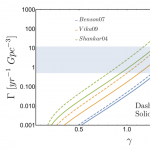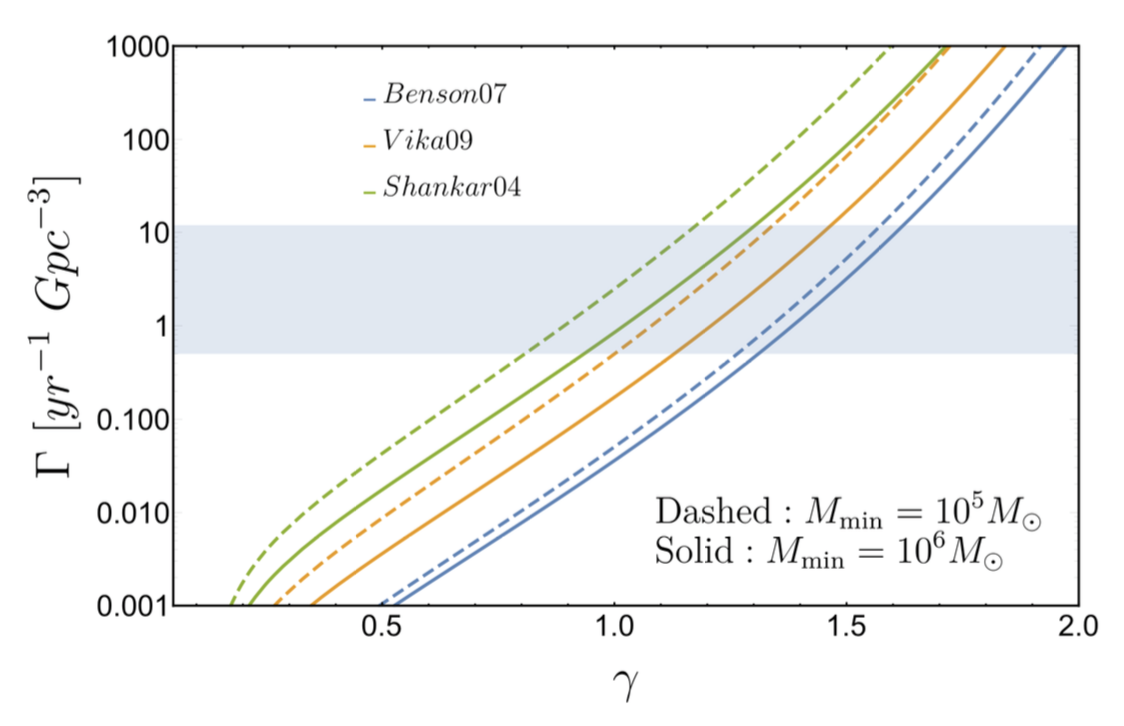Paper of the month: Primordial-black-hole mergers in dark-matter spikes

On September 14, 2015, the two detectors belonging to the Laser Interferometer Gravitational-wave Observatory (LIGO) independently observed gravitational-waves from two merging black holes [1]. The existence of gravitational-waves was originally postulated by Albert Einstein in 1916
as a necessary consequence of his General Theory of Relativity. Despite search efforts spanning nearly 50 years, this was the
first ever detection of gravitational-waves; and also the fi
rst ever detection of a merging black hole binary, making this a monumental occasion in world of physics.
September 19, 2017 by tiinatimonen
To-date, LIGO has confi
rmed the observation of three black hole binary mergers, with two of these events originating from black holes with masses near 30M
[1, 2, 3]. The detection of gravitational waves produced in these events has started a renewed interest towards a fascinating hypothesis: the primordial black holes (PBH), i.e. black holes originating in the early Universe from e.g. inflation or phase transitions, could constitute dark matter.
The idea that a signi
cant fraction of dark matter is comprised of these PBHs has been met with signi
cant skepticism. The reason is that PBH dark matter was searched for and extensively constrained in the 1990s and early 2000s using micro-lensing surveys, cosmic microwave measurements and observations of white dwarfs. Nevertheless, if the distribution of PBH masses is sufficiently peaked around 30M
, it is conceivable that PBHs could make the entirely of dark matter and account for the recent aforementioned LIGO observations. In fact, a number of physicists have pointed out that constraints on the fraction of dark matter that is comprised of black holes with masses in this particular range are subject to a number of caveats, making them a viable dark matter candidate.
Recently, a paper by Hiroya Nishikawa, Ely Kovetz, Marc Kamionkowski, and Joseph Silk [4] attempted to answer a fundamental question arising from this PBH dark matter hypothesis: is the predicted merger rate of this dark matter candidate consistent with LIGO observations? It was suggested in [5] that if the dark matter pro
le of the galaxy is cuspy, as suggested by simulations, rather than cored, then the presence of a super massive black hole (SMBH) at the center of the galaxy can create high density dark-matter spikes. Using predictions of the dark matter density in these spites, authors of [4] found that, under reasonable astrophysical assumptions, PBH mergers in near SMBH can dominate the total merger rate and, depending on the properties of the SMBH and the galactic dark matter halo, accommodate LIGO's observed merger rate. This is illustrated in
figure 1; here, LIGO's measurement of the merger rate is shown as a colored band, while predicted merger rates are reported as a function of the dark matter density pro
le inner slope. Different curves represent different assumptions of the SMBH mass function, i.e. the function describing the evolution and distribution of SMBHs, (depicted using different colors) and of the minimum mass of SMBH (depicted using different lines).

Figure 1: Comparison of predicted PBH merger rates (curves) with the inferred black hole merger rate of LIGO (blue band), shown as a function of the inner slope of the dark matter density pro
file. Various lines show illustrate the effect of the assumptions on the SMBH mass distribution.
While this was an important test for the PBH-dark-matter hypothesis, far more work needs to be done before this theory can cast away the shadow of doubt that has been looming over it since its inception. As additional interferometers come online, localization of gravitational-wave observations should drastically improve, thus allowing for an immediate test of the contribution to black hole merger rates from regions near SMBHs. Furthermore, additional micro-lensing surveys, 21cm measurements by the Square Kilometer Array (SKA) [6], and future observations by radio telescopes of the lensing of fast radio bursts, should allow for a de
nitive near-future test of the contribution of 30M
PBH to dark matter.
Text by Edoardo Vitagliano and Samuel Witte
References
[1] Virgo, LIGO Scientific collaboration, B. P. Abbott et al.,
Observation of Gravitational Waves from a Binary Black Hole Merger,
Phys. Rev. Lett. 116 (2016) 061102, [1602.03837].
[2] Virgo, LIGO Scientific collaboration, B. P. Abbott et al.,
GW151226: Observation of Gravitational Waves from a 22-Solar-Mass
Binary Black Hole Coalescence, Phys. Rev. Lett. 116 (2016) 241103,
[1606.04855].
[3] VIRGO, LIGO Scientific collaboration, B. P. Abbott et al.,
GW170104: Observation of a 50-Solar-Mass Binary Black Hole
Coalescence at Redshift 0.2, Phys. Rev. Lett. 118 (2017) 221101,
[1706.01812].
[4] H. Nishikawa, E. D. Kovetz, M. Kamionkowski and J. Silk,
Primordial-black-hole mergers in dark-matter spikes, 1708.08449.
[5] P. Gondolo and J. Silk, Dark matter annihilation at the galactic center,
Phys. Rev. Lett. 83 (1999) 1719{1722, [astro-ph/9906391].
[6] J.-O. Gong and N. Kitajima, Small-scale structure and 21cm
fluctuations by primordial black holes, JCAP 1708 (2017) 017,
[1704.04132].


